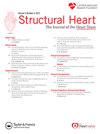提高经导管主动脉瓣置换术的效率:1000例TAVR手术的经验
IF 2.8
Q3 CARDIAC & CARDIOVASCULAR SYSTEMS
引用次数: 0
摘要
自2011年美国食品和药物管理局批准经导管主动脉瓣置换术(TAVR)以来,技术的进步和程序的改进提高了效率和安全性。通过系统地消除原始TAVR方案中的步骤,我们在不影响结果的情况下减少了手术时间、造影剂体积和透视时间。方法分析2012年11月至2023年9月的TAVR数据,重点分析手术时间、造影剂体积、辐射暴露和结果。比较了四种方案修改:传统方案(2012年至2016年)、取消旋转血管造影(2017年至2020年)、取消球囊瓣膜成形术(2020年至2022年)和取消股动脉血管造影(2022年至2023年)。结果1095例TAVR手术中,88.5%为股骨通路,86.0%为清醒镇静。患者平均年龄79.0±8.7岁,男性占59%。大多数患者被胸外科学会分类为中危(38.4%),其次是禁忌性(30.0%)、高风险(23.9%)和低危(7.4%)。平均手术时间、造影剂体积、透视时间分别为88.4±38.0 min、73.0±38.8 mL、13.8±7.9 min。不良事件发生率为15%,其中血管并发症(3.7%)最为常见。死亡率为1.5%,经根尖最高(15%),股骨最低(0.3%)。方案修改与手术时间(59.99±15.2 vs 97.8±33.9分钟)、造影剂使用(40.1±26.6 vs 92.9±38.1 mL)、透视时间(8.6±7.4 vs 18.5±8.5分钟)和并发症(5.5 vs 25.6%)的显著减少相关,均p <; 0.001。系统地取消手术步骤与减少手术时间、造影剂使用和透视时间相关,且不影响患者安全。这些改进可以提高手术效率和患者预后。本文章由计算机程序翻译,如有差异,请以英文原文为准。
Improving Efficiency in Performing Transcatheter Aortic Valve Replacement Procedure: Experience With 1000 TAVR Procedures
Background
Since Food and Drug Administration approval of transcatheter aortic valve replacement (TAVR) in 2011, advancements in technology and procedural refinements have improved efficiency and safety. By systematically eliminating steps in the original TAVR protocol, we achieved reductions in procedural time, contrast volume, and fluoroscopy time without compromising outcomes.
Methods
Institutional TAVR data (November 2012 to September 2023) were analyzed, focusing on procedural times, contrast volume, radiation exposure, and outcomes. Four protocol modifications were compared: traditional protocol (2012 to 2016), elimination of rotational angiogram (2017 to 2020), elimination of balloon valvuloplasty (2020 to 2022), and elimination of femoral angiogram (2022 to 2023).
Results
Among 1095 TAVR procedures, 88.5% were femoral access, and 86.0% were done under conscious sedation. The mean age of patients was 79.0 ± 8.7 years, with 59% males. Most patients were classified in the Society of Thoracic Surgeons intermediate-risk category (38.4%), followed by prohibitive risk (30.0%), high risk (23.9%), and low risk (7.4%). Average procedural time, contrast volume, and fluoroscopy time were 88.4 ± 38.0 minutes, 73.0 ± 38.8 mL, and 13.8 ± 7.9 minutes, respectively. Adverse events occurred in 15%, with vascular complications (3.7%) being the most common. Mortality was 1.5%, highest in transapical (15%) and lowest in femoral (0.3%). Protocol modifications were associated with significant reductions in procedural time (59.99 ± 15.2 vs. 97.8 ± 33.9 minutes), contrast use (40.1 ± 26.6 vs. 92.9 ± 38.1 mL), fluoroscopy time (8.6 ± 7.4 vs. 18.5 ± 8.5 minutes), and complications (5.5 vs. 25.6%), all p < 0.001.
Conclusions
Systematic elimination of procedural steps was associated with reduced procedural time, contrast use, and fluoroscopy time, without compromising patient safety. These refinements may enhance procedural efficiency and patient outcomes.
求助全文
通过发布文献求助,成功后即可免费获取论文全文。
去求助
来源期刊

Structural Heart
Medicine-Cardiology and Cardiovascular Medicine
CiteScore
1.60
自引率
0.00%
发文量
81
 求助内容:
求助内容: 应助结果提醒方式:
应助结果提醒方式:


